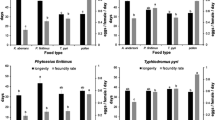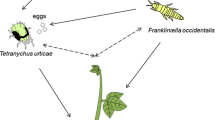Oviposition behavior may be affected by the presence of potential future competitors, mates, or predators of offspring. We examined patch choice, oviposition site preference and egg production in the predaceous mites Phytoseiulus persimilis and Neoseiulus californicus (Acari: Phytoseiidae) when given a choice between paired spider mite patches with and without conspecific eggs, with and without heterospecific eggs, and with conspecific or heterospecific eggs. Neoseiulus californicus females had no patch preference and distributed their eggs randomly in all choice situations. This was also the case with P. persimilis females given a choice between patches with and without conspecific eggs and between patches with either con- or heterospecific eggs. Phytoseiulus persimilis females confronted with patches with and without heterospecific eggs preferentially stayed and oviposited in the predator free patches. We discuss the oviposition strategies of P. persimilis and N. californicus with respect to food competition, cannibalism and intraguild predation.




Similar content being viewed by others
References
Agresti, A. (2002). Analysing repeated categorical response data. In Agresti, A. (ed.), Categorial data analysis. John Wiley & Sons, Inc., pp. 455–491.
Blaustein, L. (1999). Oviposition site selection in response to risk of predation: evidence from aquatic habitats and consequences for population dynamics and community structure. In Wasser, S. P. (ed.), Evolutionary theory and processes: modern perspectives, Kluwer, Dordrecht, pp. 441–456.
Bühl, A., and Zöfel, P. (2002). SPSS 11. Einführung in die moderne Datenanalyse unter Windows. Person Studium, München.
Charnov, E. L., and Skinner, S. W. (1985). Complementary approaches to the understanding of parasitoid oviposition decisions. Environ. Entomol. 14: 300–305.
Croft, B. A., Luh, H.-K., and Schausberger, P. (1999). Larval size relative to larval feeding, cannibalism of larvae, egg or adult female size and larval-adult setal patterns among 13 phytoseiid mite species. Exp. Appl. Acarol. 23: 599–610.
Dosse, G. (1958). Über einige neue Raubmilbenarten (Acar. Phytoseiidae). Pflanzensch. Ber. 21: 44–61.
Elgar, M. A., and Crespi, B. J. (1992). Cannibalism: ecology and evolution among diverse taxa, Oxford University Press, Oxford.
Enigl, M., and Schausberger, P. (2004). Mate choice in the predaceous mite Phytoseiulus persimilis: evidence of self-referent phenotype matching? Ent. Exp. Appl. 112: 21–28.
Fox, L. R. (1975). Cannibalism in natural populations. Annu. Rev. Ecol. Syst. 6: 87–106.
Friese, D. D., and Gilstrap, F. E. (1982). Influence of prey availability on reproduction and prey consumption of Phytoseiulus persimilis, Amblyseius californicus and Metaseiulus occidentalis (Acarina: Phytoseiidae). Int. J. Acarol. 8: 85–89.
Gilstrap, F. E., and Friese, D. D. (1985). The predatory potential of Phytoseiulus persimilis, Amblyseius californicus, and Metaseiulus occidentalis (Acarina. Phytoseiidae). Int. J. Acarol. 11: 163–168.
Grostal, P., and Dicke, M. (1999). Direct and indirect cues of predation risk influence behavior and reproduction of prey: a case for acarine interactions. Behav. Ecol. 10: 422–427.
Grostal, P., and Dicke, M. (2000). Recognising one's enemies: a functional approach to risk assessment by prey. Behav. Ecol. Sociobiol. 47: 258–264.
Janssen, A., Bruin, J., Jacobs, G., Schraag, R., and Sabelis, M. W. (1997). Predators use volatiles to avoid prey patches with conspecifics. Anim. Behav. 66: 223–232.
Janssen, A., Pallini, A., Venzon, M., and Sabelis, M. W. (1999). Absence of odour-mediated avoidance of heterospecific competitors by the predatory mite Phytoseiulus persimilis. Entomol. Exp. Appl. 92: 73–82.
McMurtry, J. A., and Croft, B. A. (1997). Life-styles of phytoseiid mites and their roles in biological control. Annu. Rev. Entomol. 42: 291–321.
Nagelkerke, C. J. (1994). Simultaneous optimization of egg distribution and sex allocation in a patch-structured population. Am. Nat. 144: 262–284.
Nagelkerke, C. J., Van Baalen, M., and Sabelis, M. W. (1996). When should a female avoid adding eggs to the clutch of another female? A simultaneous oviposition and sex allocation game. Evol. Ecol. 10: 475–497.
Nagelkerke, C. J., and Sabelis, M. W. (1998). Precise control of sex allocation in pseudo-arrhenotokous phytoseiid mites. J. Evol. Biol. 11: 649–684.
Palevsky, E., Reuveny, H., Okonis, O., and Gerson, U. (1999). Comparative behavioural studies of larval and adult stages of the phytoseiids (Acari: Mesostigmata) Typhlodromus athiasae and Neoseiulus californicus. Exp. Appl. Acarol. 23: 467–485.
Polis, G. A. (1981). The evolution and dynamics of intraspecific predation. Annu. Rev. Ecol. Syst. 12: 225–251.
Polis, G. A., Myers, C. A., and Holt, R. D. (1989). The ecology and evolution of intraguild predation: potential competitors that eat each other. Annu. Rev. Ecol. Syst. 20: 297–330.
Sabelis, M. W., and Dicke, M. (1985). Long-range dispersal and searching behaviour. In Helle, W., and Sabelis, M. W. (eds.), Spider mites: Their biology, natural enemies and Control, Volume 1B, Elsevier, Amsterdam, pp. 141–160.
Sabelis, M. W., and Janssen, A. (1994). Evolution of life-history patterns in the Phytoseiidae. In Houck, M. A. (ed.), Mites: Ecological and evolutionary analyses of life-history patterns, Chapman & Hall, New York, pp. 70–98.
Sabelis, M. W., Nagelkerke, C. J., and Breeuwer, J. A. J. (2002). Sex ratio control in arrhenotokous and pseudo-arrhenotokous mites. In Hardy, I. C. W. (ed.), Sex Ratios—Concepts and Research Methods, Cambridge University Press, Cambridge, pp. 235–253.
Schausberger, P., and Croft, B. A. (1999). Predation and discrimination between con- and heterospecific eggs among specialist and generalist phytoseiid mite species (Acari: Phytoseiidae). Environ. Entomol. 28: 523–528.
Schausberger, P., and Croft, B. A. (2000). Cannibalism and intraguild predation among phytoseiid mites: are aggressiveness and prey preference related to diet specialization? Exp. Appl. Acarol. 24: 709–725.
Schausberger, P., and Croft, B. A. (2001). Kin recognition and larval cannibalism by adult females in specialist predaceous mites. Anim. Behav. 61: 459–464.
Schausberger, P. (2004). Ontogenetic isolation favours sibling cannibalism in predatory mites. Anim. Behav. 67: 1031–1035.
Schausberger, P. (2005). The predatory mite Phytoseiulus persimilis manipulates imprinting among offspring through egg placement. Behav. Ecol. Sociobiol. 58: 53–59.
Schausberger, P., and Walzer, A. (2001). Combined versus single species release of predaceous mites: predator-predator interactions and pest suppression. Biol. Control 20: 269–278.
Thompson, J. N. (1988). Evolutionary ecology of the relationship between oviposition preference and performance of offspring in phytophagous insects. Entomol. Exp. Appl. 47: 3–14.
Vanas, V., Enigl, M., Walzer, A., and Schausberger, P. (2006). The predatory mite Phytoseiulus persimilis adjusts patch leaving to own and progeny prey needs. Exp. Appl. Acarol. 39: 1–11.
Walzer, A., Blümel, S., and Schausberger, P. (2001). Population dynamics of interacting predatory mites, Phytoseiulus persimilis and Neoseiulus californicus, held on detached bean leaves. Exp. Appl. Acarol. 25: 731–743.
Walzer, A., and Schausberger, P. (1999a). Cannibalism and interspecific predation in the phytoseiid mites Phytoseiulus persimilis and Neoseiulus californicus: predation rates and effects on reproduction and juvenile development. Bio Control. 43: 457–468.
Walzer, A., and Schausberger, P. (1999b). Predation preferences and discrimination between con- and heterospecific prey by the phytoseiid mites Phytoseiulus persimilis and Neoseiulus californicus. Bio Control. 43: 467–478.
Acknowledgments
Andreas Walzer was funded by the Austrian Ministry of Agriculture and Forestry, Environment and Water Management. Peter Schausberger was funded by the Austrian Academy of Sciences (APART; Austrian Programme for Advanced Research and Technology). We thank Monika Enigl, University of Natural Resources and Applied Life Sciences, Vienna for critical reading of the manuscript.
Author information
Authors and Affiliations
Corresponding author
Rights and permissions
About this article
Cite this article
Walzer, A., Paulus, H.F. & Schausberger, P. Oviposition Behavior of Interacting Predatory Mites: Response to the Presence of Con- and Heterospecific Eggs. J Insect Behav 19, 305–320 (2006). https://doi.org/10.1007/s10905-006-9025-4
Revised:
Accepted:
Published:
Issue Date:
DOI: https://doi.org/10.1007/s10905-006-9025-4




